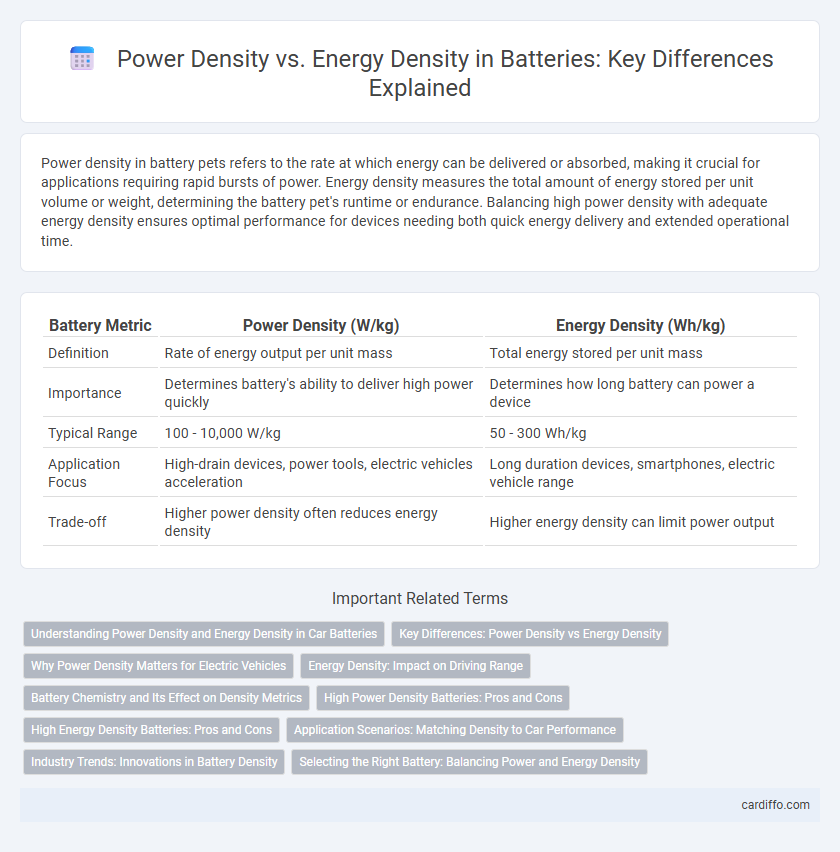Power density in battery pets refers to the rate at which energy can be delivered or absorbed, making it crucial for applications requiring rapid bursts of power. Energy density measures the total amount of energy stored per unit volume or weight, determining the battery pet's runtime or endurance. Balancing high power density with adequate energy density ensures optimal performance for devices needing both quick energy delivery and extended operational time.
Table of Comparison
| Battery Metric | Power Density (W/kg) | Energy Density (Wh/kg) |
|---|---|---|
| Definition | Rate of energy output per unit mass | Total energy stored per unit mass |
| Importance | Determines battery's ability to deliver high power quickly | Determines how long battery can power a device |
| Typical Range | 100 - 10,000 W/kg | 50 - 300 Wh/kg |
| Application Focus | High-drain devices, power tools, electric vehicles acceleration | Long duration devices, smartphones, electric vehicle range |
| Trade-off | Higher power density often reduces energy density | Higher energy density can limit power output |
Understanding Power Density and Energy Density in Car Batteries
Power density in car batteries measures the rate at which energy can be delivered to the vehicle's motor, crucial for acceleration and high-power demands, while energy density indicates the total amount of energy stored, affecting driving range. Higher power density batteries enable quick bursts of energy output but may sacrifice total capacity, whereas higher energy density batteries provide longer range but deliver energy more slowly. Balancing power density and energy density is key for optimizing electric vehicle performance, as lithium-ion chemistry typically offers a strong compromise between the two metrics.
Key Differences: Power Density vs Energy Density
Power density measures how quickly a battery can deliver energy, reflecting its ability to provide high bursts of power for short durations, while energy density indicates the total amount of energy stored per unit mass or volume, determining battery life and runtime. High power density is crucial for applications like electric vehicles' acceleration and power tools, whereas high energy density benefits devices requiring long-lasting energy, such as smartphones and electric cars for extended driving range. The key difference lies in power density emphasizing discharge rate capability, whereas energy density focuses on total energy capacity.
Why Power Density Matters for Electric Vehicles
Power density in batteries defines the rate at which energy can be delivered, crucial for electric vehicles to achieve rapid acceleration and efficient regenerative braking. High power density enables faster charging and discharging without compromising battery life, directly enhancing vehicle performance and driving experience. Optimizing power density alongside energy density ensures electric vehicles balance long driving ranges with the ability to handle high power demands.
Energy Density: Impact on Driving Range
Energy density, measured in watt-hours per kilogram (Wh/kg), directly influences a battery's ability to store energy, thereby extending a vehicle's driving range. Higher energy density enables electric vehicles to travel longer distances on a single charge without increasing battery weight. Improvements in lithium-ion and solid-state batteries are critical for achieving greater driving range through enhanced energy density.
Battery Chemistry and Its Effect on Density Metrics
Battery chemistry significantly influences power density and energy density, with lithium-ion variants offering high energy density due to their efficient electrode materials, such as lithium cobalt oxide or lithium iron phosphate. Power density, critical for applications requiring rapid energy discharge, depends on the battery's ability to facilitate fast ion transport and electron flow, often enhanced by chemistries like lithium titanate or nickel-metal hydride. Optimizing battery chemistry balances these density metrics to meet specific performance needs in electric vehicles, portable electronics, and grid storage systems.
High Power Density Batteries: Pros and Cons
High power density batteries deliver rapid energy discharge, making them ideal for applications requiring quick bursts of power such as electric vehicles and power tools. These batteries offer superior charge and discharge rates but typically suffer from lower energy density, limiting their runtime compared to high energy density batteries. Their shorter cycle life and increased heat generation pose challenges in thermal management and long-term durability.
High Energy Density Batteries: Pros and Cons
High energy density batteries provide greater energy storage capacity per unit volume, enabling longer device runtimes and reduced battery size, critical for electric vehicles and portable electronics. However, they often suffer from lower power density, limiting the rate at which energy can be delivered quickly, and may pose challenges in thermal management and safety. Despite these drawbacks, their high energy density remains essential for applications requiring extended operational life without frequent recharging.
Application Scenarios: Matching Density to Car Performance
High power density batteries deliver rapid energy bursts ideal for acceleration and quick response in electric vehicles, supporting dynamic driving conditions and regenerative braking systems. Energy density batteries provide extended driving range by storing more energy per unit weight, essential for long-distance travel and minimizing charging frequency. Selecting the appropriate balance between power density and energy density optimizes vehicle performance, aligning battery capabilities with specific use cases such as city commuting or highway cruising.
Industry Trends: Innovations in Battery Density
Industry trends in battery technology emphasize breakthroughs in power density and energy density to meet growing demands for electric vehicles and grid storage. Innovations include solid-state batteries and advanced lithium-silicon chemistries that enhance energy density while maintaining high power output. These advancements enable longer driving ranges and faster charging times, driving the electrification revolution in transportation and renewable energy sectors.
Selecting the Right Battery: Balancing Power and Energy Density
Selecting the right battery requires balancing power density, which determines the ability to deliver high bursts of energy quickly, and energy density, which defines the total energy stored for long-term use. High power density batteries are essential for applications requiring rapid discharge, such as electric vehicles during acceleration, while high energy density batteries extend battery life for devices like smartphones and electric grids. Optimizing this balance ensures efficient performance tailored to specific needs, enhancing functionality and longevity.
Power Density vs Energy Density Infographic

 cardiffo.com
cardiffo.com